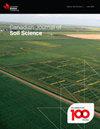黑黑土厚黑土上连续多年生草、多年生草-豆科杂交种和一年生谷物下有机碳的管理影响
IF 1.5
4区 农林科学
Q4 SOIL SCIENCE
引用次数: 0
摘要
采用CAESA(1994 ~ 1997)和BMP(2008 ~ 2012)两项试验,研究了一年生和多年生牧草管理对土壤有机碳(SOC)和等效SOC储量(等土壤质量基础)的影响。1992年破除多年生草地原址,1993年建立CAESA试验区。1994年至1997年期间,一半的围场种植了冬季小黑麦和小黑麦与春大麦的混合物;一半包括光滑的和草甸的雀稗;每个围场都是轻度、中度或重度放牧。BMP试验(2008年至2012年)在同一围场进行,包括施肥、直接播种的大麦作为青贮饲料;未施肥的草甸雀麦、施肥的草甸雀麦和草甸雀麦与苜蓿混播的放牧和放牧;还有从1994年开始就连续生长的未施肥的老草。在试验期间(1998年至2007年),所有围场都没有施肥。1994 ~ 2012年,在0 ~ 15 cm深度,老草土壤有机碳保持不变,平均为88 Mg C ha-1。到2012年,青贮大麦土壤有机碳由89 Mg C ha-1下降到72 Mg C ha-1。1994 ~ 2012年间,在原一年生饲料(1994 ~ 1998)上重新建立的所有处理中,土壤有机碳含量均有所下降,但未达到大麦青贮的水平。轻组分碳(LFC)在老草青贮下最高,大麦青贮下最低。总体而言,未施用化肥的老草土壤有机碳保持不变,尽管一年生土壤有机碳储量减少。因此,复植多年生牧草可以减少有机碳损失,而放牧多年生牧草则不能。本文章由计算机程序翻译,如有差异,请以英文原文为准。
Management Impacts on Organic Carbon Under Continuous Perennial Grass, Perennial Grass-Legume Mixture, And Annual Cereals On A Thick Black Chernozemic Soil
Impacts of annual and perennial pasture management on soil organic carbon (SOC) and equivalent SOC stocks (equal soil mass basis) were investigated in two trials [(CAESA (1994 to 1997) and BMP (2008 to 2012) trials] conducted on the same experimental paddocks at Lacombe, Alberta. The original site was broken from perennial grass in 1992 and the CAESA trial established in 1993. Between 1994 and 1997, half of the paddocks included winter triticale and a mixture of triticale and spring barley; half included smooth and meadow bromegrass; and each paddock was light, medium, or heavily grazed. The BMP trial (2008 to 2012) on the same paddocks included fertilized, direct seeded barley as silage; grazing and haying of unfertilized meadow bromegrass, fertilized meadow bromegrass, and meadow bromegrass and alfalfa mixture; and unfertilized oldgrass that was continuous since 1994. Between trials (1998 to 2007) all paddocks received no fertilizer. In the 0-15 cm depth SOC under oldgrass was constant between 1994 and 2012 and averaged 88 Mg C ha-1. Under barley silage SOC decreased from 89 to 72 Mg C ha-1 by 2012. Between 1994 and 2012 SOC decreased in all treatments re-established on original annual forage (1994 to 1998) but not to the level of barley silage. Light fraction carbon (LFC) was highest under oldgrass and lowest under barley silage. Overall, oldgrass with no fertilizer inputs maintained a constant SOC, although annuals reduced SOC stocks. Re-establishment of perennial grass with grazing may therefore reduce SOC loss whereas haying perennial grass may not.
求助全文
通过发布文献求助,成功后即可免费获取论文全文。
去求助
来源期刊

Canadian Journal of Soil Science
农林科学-土壤科学
CiteScore
2.90
自引率
11.80%
发文量
73
审稿时长
6.0 months
期刊介绍:
The Canadian Journal of Soil Science is an international peer-reviewed journal published in cooperation with the Canadian Society of Soil Science. The journal publishes original research on the use, management, structure and development of soils and draws from the disciplines of soil science, agrometeorology, ecology, agricultural engineering, environmental science, hydrology, forestry, geology, geography and climatology. Research is published in a number of topic sections including: agrometeorology; ecology, biological processes and plant interactions; composition and chemical processes; physical processes and interfaces; genesis, landscape processes and relationships; contamination and environmental stewardship; and management for agricultural, forestry and urban uses.
 求助内容:
求助内容: 应助结果提醒方式:
应助结果提醒方式:


